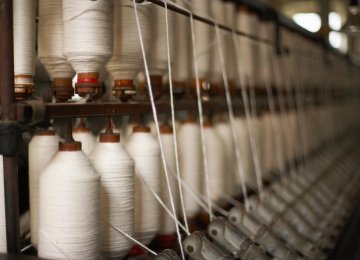As the government plans to sharply boost textile production over the coming decade, the systemic pressure from neighboring countries that base their respective garment industries on a strong domestic cotton sector will not diminish. The only way forward will be to boost cotton production through a better subsidy regime and additional financial lifelines.
President Hassan Rouhani’s Administration is right to put its weight behind the textile industry. It is a labor-intensive industry accounting for 13% of total employment in the industrial sector, directly employing 280,000 people. Manufacturing facilities also tend to have more personnel on average than other industrial sectors. Textile manufacturing will be one of the ways with which the government plans to tackle high unemployment rates.
The Ministry of Industries, Mining and Trade recently released Iran’s first long-term industrial program in over 15 years, called the Strategic Plan. It sets out production targets for textile products amounting to an increase of around 50% for most sectors over the next 10 years (see graph).
It remains to be seen whether this target is achievable. In particular, the main deficiency of Iran’s textile industry is its heavy dependence on cotton imports in combination with inadequate government subsidies.
Iran currently imports around 40,000 tons of cotton every year, mainly from Uzbekistan and Turkmenistan. Simultaneously, domestic production has fallen to around 170,000 tons, almost 40% of which are produced in the north-eastern province of Khorasan Razavi.
Industry experts point out that if the government increased subsidies, cotton imports could be halted. A 2009 report by the Association of Iran Textile Industries scorns the removal of subsidies of 350 rials per kilo of cotton–a figure already low by international standards.
As a result, cotton output shrank from around 600,000 tons in 1997 to an average of 300,000 tons in the past years. Since 2012, sanctions have caused a further decline in cotton output. Iran’s 140 cotton facilities have an annual production capacity of 349,000 tons, but production in 2013 stood at only 190,000 tons, according to data from the Ministry of Agricultural Jihad.
Experts increasingly acknowledge that a strong domestic cotton sector is the basis for a flourishing textile industry.
This feature marks the economies of Iran’s neighbors, which further skews the game against Iran. Turkey, Pakistan and Turkmenistan have all built their textile industries around a large domestic cotton sector (see graph). In Uzbekistan too, the clothing sector has been booming over the past few years on the back of its already well-established cotton industry.
But for Iran and the Middle East, Turkey is particularly important. Its highly competitive textile and clothing industry not only enjoys the advantages of domestically produced cotton, but is also built around free trade agreements with Europe. The success of Turkey lies in direct access to the European market while operating at much lower labor costs. This has not been without criticism: NGO research conducted under the name of “Clean Clothes Campaign” has shown that competitiveness lies partly in paying wages far under the legally allowed minimum wage and making extensive use of temporary contracts.
More recently, China has started to overtake Turkey’s exporter position to the Middle East and Europe, driven by the flooding of these markets by low-cost products and the extension of liberalized trade. Iran has increasingly substituted cotton and clothing imports from its neighbors by Chinese produce.
Iran’s position amid these large producers has been one of protectionism. But high import tariffs, lower production costs and the vast textile supply of Iran’s neighbors have had the unfortunate effect of a significant uptick in smuggling over the past years. Of the $12 billion of clothes exported annually by Turkey, as much as $2 billion find their way illegally into Iran, according to the Ministry of Industries, Mining and Trade. Smuggling also flows in from Iran’s eastern border with Pakistan and its northern border with Turkmenistan.
It is increasingly evident that smuggling and tough international competition are ravaging the Iranian cotton and textile industry. Many players of the sector put the official imports of clothes at less than 10%, which has compelled officials to take a strict stance against smuggling. Clothing production has been falling over the past years and currently only 20% of the country’s demand for apparel are met domestically, according to a member of Association of Iran Textile Industries, Gholamali Rokhsat.
The government realizes that the clothing industry has little chance without a strong cotton sector, and has decided to respond pragmatically to garment smuggling. The Industries Ministry has decided to halve the tariff on clothes from 150% (taking into account customs duties and trading profits) to 75%. Additionally, the managing director of Maku Free Trade Zone announced that Iran is planning to embark on joint venture production of clothes with Turkey in the FTZ.
“The high import tariffs on apparel have caused the market to be dominated by contraband clothing smuggled from Turkey to Iran. By establishing joint clothes manufacturing units, we can control the market and regain the revenues the government is losing due to rampant smuggling,” Mehr News Agency quoted Hossein Forouzan as saying.
The government should realize that in the regional competitive climate, the only way to achieve its ambitious textile production targets will be to take care of the cotton industry first.





